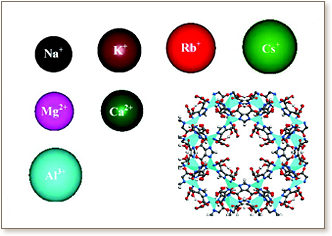


A molecular simulation study is reported for CO 2 adsorption in rho zeolite-like metal-organic framework (rho-ZMOF) exchanged with a series of cations (Na +, K +, Rb +, Cs +, Mg 2+, Ca 2+, and Al 3+). The isosteric heat and Henry's constant at infinite dilution increase monotonically with increasing charge-to-diameter ratio of cation (Cs + < Rb + < K + < Na + < Ca 2+ < Mg 2+ < Al 3+). At low pressures, cations act as preferential adsorption sites for CO 2 and the capacity follows the charge-to-diameter ratio. However, the free volume of framework becomes predominant with increasing pressure and Mg-rho-ZMOF appears to possess the highest saturation capacity. The equilibrium locations of cations are observed to shift slightly upon CO 2 adsorption. Furthermore, the adsorption selectivity of CO 2/H 2 mixture increases as Cs + < Rb + < K + < Na + < Ca 2+ < Mg 2+ ≈ Al 3+. At ambient conditions, the selectivity is in the range of 800-3000 and significantly higher than in other nanoporous materials. In the presence of 0.1% H 2O, the selectivity decreases drastically because of the competitive adsorption between H 2O and CO 2, and shows a similar value in all of the cation-exchanged rho-ZMOFs. This simulation study provides microscopic insight into the important role of cations in governing gas adsorption and separation, and suggests that the performance of ionic rho-ZMOF can be tailored by cations.